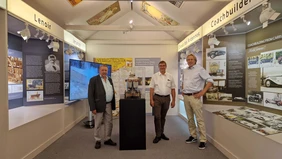It was a chance find by Dr. Dr. Gerd Treffer, head of historical projects at the Audi Confucius Institute (AKII), during research in the historical work "Astronomia Europaea" (Dillingen, 1687) on the Jesuit monk Ferdinand Verbiest, who was chief astronomer and mathematician in the Chinese Empire in the 17th century: the description of a self-propelled vehicle that got going and kept going without any human or animal help. The world's first automobile - and that about 200 years before Benz and Daimler or 100 years before James Watt. For a long time, it was unclear whether the vehicle had actually ever been built, and if so, whether it had ever driven, since there are no other mentions or contemporary witnesses of this great invention.
This scientific proof was provided by the Technische Hochschule Ingolstadt (THI) through the true to original reproduction of the vehicle. Together with the Chinese partner university South China University of Technology (SCUT) in Guangzhou, a German-Chinese student project reconstructed and rebuilt the first real driving model of the world's first automobile. The project was led by Prof. Dr. Thomas Suchandt, who reads construction.
After a feasibility study, a prototype vehicle was created with modern materials and was actually able to run. After that, historical research on the mechanics had to be done in meticulous detail. For example, the deflection from the vertical to the horizontal axle of the wheels could only have been transferred with wooden basket and comb wheels. Likewise, a drawbar was not yet known at that time. Carriages were "pulled" around the curve by horses with their rigid axles. This explains the fifth wheel on the automobile, which must have acted like a boat rudder to make the vehicle go in circles.
Only the steam pressure boiler is not original. For safety and product liability reasons, such a thing is no longer manufactured today. The maiden voyage took place in Ingolstadt in 2021, and the vehicle really did drive. This provided experimental proof that Verbiest's vehicle could actually drive independently. Through supraregional reporting, the Autoworld Museum in Brussels also learned of this and asked for a sample for their world-famous exhibition.
So Prof. Peter Augsdörfer, lecturer at the THI Business School for Management Strategy and Technology and Innovation Management, in his function as head of AKII, together with project manager Prof. Thomas Suchandt and Gerd Treffer traveled to Brussels in July for the ceremonial handover. The vehicle was ceremoniously handed over in the Autoworld Museum in the presence of Belgian aristocratic dignitaries as well as the press with a glass of champagne. It now stands there as a permanent exhibit with a reference to Ingolstadt Technical University.


![[Translate to English:] The image shows the replica of the first automobile. A steam boiler on four wooden wheels and a fifth wooden wheel on the back.](/fileadmin/_processed_/c/5/csm_Bild_Fahrzeug_website_4eec95b23f.webp)
![[Translate to English:] Logo Akkreditierungsrat: Systemakkreditiert](/fileadmin/_processed_/2/8/csm_AR-Siegel_Systemakkreditierung_bc4ea3377d.webp)








![[Translate to English:] Logo IHK Ausbildungsbetrieb 2023](/fileadmin/_processed_/6/0/csm_IHK_Ausbildungsbetrieb_digital_2023_6850f47537.webp)


